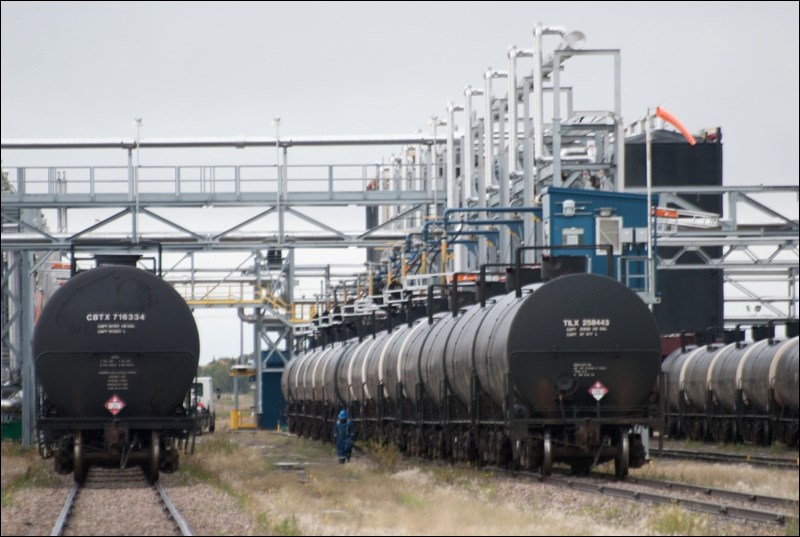On Nov. 28, Alberta Premier Rachel Notley announced her province is going to be acquiring unit trains to get her province’s landlocked oil moving. Not only has she committed money to Trans Mountain Expansion, but now rail, too. This premier is serious.
However, there’s a big problem with her numbers. She spoke of $350 million to purchase up to 7,000 rail cars and 80 locomotives. That $350 million doesn’t come even close. It might be enough to lease those units for a few years. Her stated intention was this was a short-term solution, and the life expectancy of a locomotive and tanker cars is easily into three or four decades.
However, she said, “Alberta will buy rail cars ourselves in our fight to get top dollar for the resources that belong to every Albertan.”
I never saw “lease” mentioned once.
Notley spoke of 120,000 barrels per day (bpd) of capacity. Her initial statements weren’t very clear, as someone with little knowledge of the business might think she just meant two sets of 100 or 120 car trains. That wasn’t at all what she meant.
She meant enough trains to keep 120,000 barrels per day in motion, each and every day. That’s a lot of rail cars, and a lot of locomotives.
One of the few things I learned in my failed attempt at engineering college was how to do table napkin estimations. Your numbers may not be perfect, but reasonable estimations will usually see the errors cancel each other out.
A unit train will typically be 60,000 or 70,000 barrels. So 120,000 seems to indicate two units of 60,000 barrels each. At 600 barrels per car, that would be 100 cars, but if we have 20 per cent diluent, then that’s 120 cars. (The diluent can also be as high as 30 per cent, but then again, some cars have a capacity closer to 720 barrels. You take 120 cars at 720 barrels each, then subtract 30 per cent diluent, and you get 60,480 barrels. Like I said, the errors tend to cancel each other out.)
The older DOT-111 cars which barbecued a Quebec town are being phased out now for crude oil. Newer, safer DOT-117 cars are in. And the only price I’ve been able to find was a 2015 blog entry that said 117s, at that time, cost US$160,000. At today’s exchange, that would be $212,000 Canadian. However, I have also recently seen the number $135,000 tossed around, so let’s use that for the low end.
If you’re putting it on rail, it’s going to be at least a seven-day haul. That seems like a reasonable, minimum number. When Notley initially referred to two unit trains, and 120,000 bpd capacity, everyone parroted that without any thought.
One unit train with capacity of 60,000 barrels can not move all of that in one day from pickup to delivery, nor can two unit trains move 120,000 barrels in a day.
A train is not like a plane, which can take off, span the continent, disgorge its contents, and fly back to its place of origin in the same day. To move 60,000 bpd (one unit train), you need one train at the loading point. You need a second at one day’s travel distance. You need another at spaced out along the line at another day’s travel, for as many days as it takes. So if you have a seven-day travel, you need seven trains spaced along the route, going loaded. Then you have one day unloading, and another seven trains for the seven days coming back empty (but likely hauling diluent). That means at the very minimum, 16 complete unit trains are needed for each 60,000 bpd run.
Notley’s numbers show 7,000 cars, enough for 58 sets of cars (unit trains) and 80 locomotives, enough, at two apiece, for 40 trains.
There’s a problem with her numbers, however. The current standard locomotives used by Canadian railways cost US$3 million each as of December 2017, when CN bought 200 locomotives for US$600 million. That’s $3.859 million Canadian, each, at the exchange rate at that time. Notley spoke of 80 locomotives – that’s $308.7 million. That only leaves $41.3 million for 7,000 rail cars, or $5,897 each. That’s obviously way too low. So either there’s some leasing considerations involved here, perhaps on the locomotives, or the $350 million is way too low. Remember they were asking the feds for half? Even if the feds coughed up an additional $350 million, that still leaves only $55,900 per car.
My math shows, on the low end, a price tag of $945 million for new rail cars alone. Coupled with $309 million for locomotives, and you come in at $1.254 billion. At the high end, it would be $1.484 billion for cars, totalling $1.793 billion including locomotives. Either way, it’s a heck of a lot more than the $350 million announced. Unless she’s leasing, Notley’s $350 million is only one-third to one-fifth of the money required to buy all these new trains, and no consideration has been given to staffing or operational costs.
Even so, that is very small potatoes compared to the money Alberta is losing right now, each and every day.
If we can’t build a pipeline, build those trains, whatever the cost.
Brian Zinchuk is editor of Pipeline News. He can be reached at [email protected].




